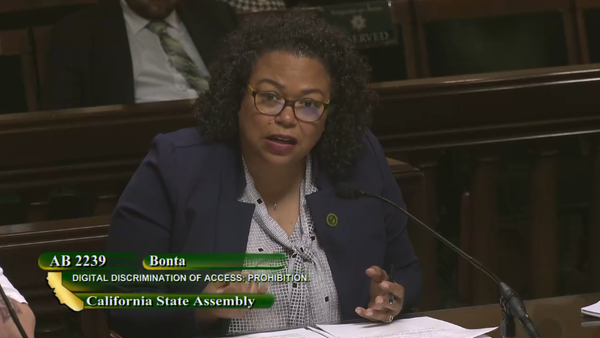Satellite, Broadband over Power Lines and Microwave Technologies Contend for Stimulus Funds
WASHINGTON, June 9, 2009 – A diverse “undercard” of broadband technologies is being largely overlooked in the battle for stimulus dollars, a panel of industry representatives said Tuesday at the June Broadband Breakfast Club.
WASHINGTON, June 9, 2009 – A diverse “undercard” of broadband technologies is being largely overlooked in the battle for stimulus dollars, a panel of industry representatives said Tuesday at the June Broadband Breakfast Club.
Though often ignored, broadband over powerlines (BPL) is a reality and moving fast – with help from existing Rural Utility Service loans, said International Broadband Electric Communications government affairs coordinator Alyssa Clemsen. Many rural electric cooperatives are choosing BPL and funding build-out with RUS loans, she said.
An initial deployment has allowed co-ops to roll equipment and service out over thousands of miles — enough to reach hundreds of rural consumers who would otherwise have no other options, Clemsen said.
“We’re a last mile provider,” she said proudly. Roughly 80 percent of households the co-ops reach have no other broadband options, she said: “They don’t have a choice.”
BPL has been more successful in Europe because its 220 volt system is more amenable to transmitting data, she said. But comparing European countries, some of which are smaller than many American states, to the U.S. market doesn’t account for many incommensurables, she saaid.
BPL can reach five homes per mile that would otherwise have no service, she said. The co-ops currently deploying BPL hope to have 300,000 subscribers over the next 18 months – to symmetrical 5 Megabit per second (Mbps) connections consumers demand from fiber, she boasted.
Satellite internet service is not the same one-way pipe sold ten years ago, said Jeffrey Carlisle, vice president of regulatory affairs for SkyTerra Communications.
The industry now boasts capabilities that have advanced by an “order of magnitude,” and are competitive with wireline connections, he said.
SkyTerra plans to have two new satellites in the air by the end of 2010, he said. The new “birds” would allow a new generation of satellite phones and internet access devices to flourish – a far cry from the “bricks” of years past, Carlisle said.
In addition, SkyTerra has obtained ancillary terrestrial licenses from the Federal Communications Commission that will allow them to offer more robust coverage over a larger area, he said.
The company’s goal is to no longer be considered a “niche player,” Carlisle said, but rather to offer a “set of services that can compete with terrestrial systems.” SkyTerra hopes to offer speeds on par with today’s third-generation wireless services, he said.
And the real utility of next generation satellite will be to drive more efficient use of spectrum by answering questions, he said. “What is out there, how are we using it, and are we using it properly?” he asked.
GigaBeam Vice President Don Peck said his company’s point-to-point and point-to-multipoint fixed wireless radio technology is more focused on speed than range. It’s a “backbone type of technology,” he said.
“If you want a gigabit, there’s no need for fiber in the ground,” he said. Although GigaBeam’s equipment can reach both residential and business customers, Peck said the marketing focus has been on businesses.
Peck didn’t directly address whether other companies have made investments in his fixed wireless-based backbone technology. When asked whether wireless carriers that rail against high “special access market” charges had investigated GigaBeam, Peck demurred. Such companies are “fiber bigots,” he quipped.
Some panelists were cautious on the need to spend the $350 million called for legislation on a national broadband map. Both satellite and BPL can be universal in coverage, they agreed. “Maps don’t matter when service is ubiquitous,” Carlisle said.
The more important function of the map will come in the future when examining underserved areas, he said. By contrast, unserved areas are a less of an issue in the long run, he said.
Editor’s Note (6/9, 6/11): This story has been modified to more properly explain the nature of GigaBeam’s technology.







